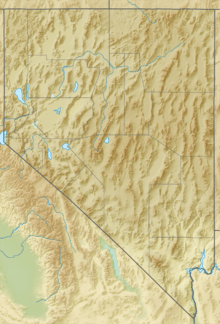Simpson Park Mountains facts for kids
Quick facts for kids Simpson Park Mountains |
|
|---|---|
| Highest point | |
| Peak | Fagan Mountain |
| Elevation | 2,788 m (9,147 ft) |
| Dimensions | |
| Length | 47.7 mi (76.8 km) NNE-SSW |
| Width | 6.2 mi (10.0 km) |
| Geography | |
| Country | United States |
| State | Nevada |
| Region | Basin and Range |
| District | Eureka and Lander counties |
| Range coordinates | 39°44.86′N 116°36.52′W / 39.74767°N 116.60867°W |
| Topo map | USGS Crescent Valley, Simpson Park and Summit Mountain 30x60 quads |
The Simpson Park Mountains, also called the Simpson Park Range, are a mountain range in central Nevada, in the western United States. They are found in Lander and Eureka counties.
These mountains reach a height of about 9,147 feet (2,788 m) at Fagan Mountain. The range covers an area of around 310 square miles (800 km2). US Route 50 crosses the very southern part of the mountains at Hickison Summit. This spot is between the towns of Eureka and Austin.
Contents
Where Are the Simpson Park Mountains?
The Simpson Park Mountains stretch from the southwest to the northeast. To their west, across Grass Valley, is the Toiyabe Range. To the east, you'll find the Roberts Mountains.
Other mountain ranges nearby include the Cortez Mountains to the north. These are across Horse Creek Valley. To the south are the Toquima and Monitor ranges. The Monitor, Kobeh, and Antelope valleys are located to the southeast.
What Can You See and Do?
The Hickison Petroglyph Recreation Area is at the southeastern end of the mountains. It is just northwest of Hickison Summit on US Route 50. This area is famous for its ancient rock carvings.
Most of the Simpson Park Mountains, about 98%, are managed by the Bureau of Land Management. The remaining 2% is privately owned.
Plants and Animals
The main types of plants in the Simpson Park Mountains are:
- Piñon-juniper trees, which cover about 43.5% of the area.
- Sagebrush scrub, covering about 25.4%.
- Sagebrush steppe, covering about 18.5%.
Trees you might see here include western juniper (Juniperus occidentalis), Utah Juniper (Juniperus osteosperma), and Single-leaf Pinyon (Pinus monophylla). Animals like coyotes and pikas also live in these mountains.
How the Mountains Got Their Name
The Simpson Park Mountains are named after James H. Simpson. He was a surveyor who mapped a travel route just south of the range in 1858.
Images for kids



